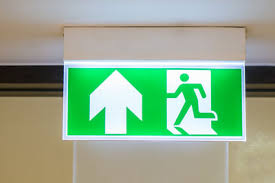Emergency Lighting
What are emergency lights?
 The purpose of emergency lighting is to ensure the lighting is provided promptly, automatically and for a suitable time when the normal power supply to the lighting fails to ensure that people within the building can evacuate safely in the event of an emergency or continue to work should the power supply failure not be classed as a hazard.
The purpose of emergency lighting is to ensure the lighting is provided promptly, automatically and for a suitable time when the normal power supply to the lighting fails to ensure that people within the building can evacuate safely in the event of an emergency or continue to work should the power supply failure not be classed as a hazard.
We offer the following services:
1. Emergency Lighting Installation
2. Emergency Lighting Repairs & Maintenance
3. Emergency Lighting Testing & Certification
There are four main types of emergency lighting to choose from:
1. Escape route lighting
2. Open area lighting
3. High-risk task area lighting
4. Standby lighting
Escape Route Lighting
Escape route emergency lighting is designed to light the route to provide the safest and fastest route to a fire exit. These lights are installed in the ceiling to illuminate the way, helping you to avoid obstacles.
Open Area Emergency Lighting
Open area emergency lighting (also known as anti-panic lighting) aims to reduce panic by providing more illumination for the occupants in the building in order for them to reach an escape route and exit safely.
This is done by placing emergency lights in open areas of the building so that when building occupants are evacuating there is as much light as possible.
High-Risk Task Area Lighting is required for factories and other industrial buildings. Workers conducting high-risk tasks, such as using machinery or working with tools, must be able to adequately see what they are doing in order to allow for a safe shut down of the equipment.
Without high-risk task area lighting, it can be extremely dangerous if the power goes out. The user would be unable to see clearly and this poses a risk of injury to themselves or others.
Standby Lighting

